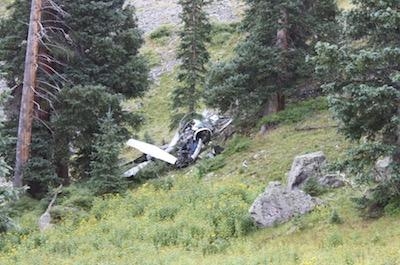Two Fatally Injured In Collision With Terrain
The NTSB has released its factual report from an accident involving a Stemme Gmbh S10-VT self-launching (powered) glider near Telluride, CO on August 24, 2016. The plot and a passenger were fatally injured when the aircraft impacted trees and terrain. The glider was registered to and operated by the pilot as a local sightseeing flight. Visual meteorological conditions prevailed for the flight, which was not operated on a flight plan. The flight originated from the Telluride Regional Airport (KTEX), Telluride, Colorado, about 1315.

According to the report, a witness reported seeing the powered glider climbing out from TEX. The engine "sounded perfect" at a constant power setting at the time. About 15 minutes later, he heard the sound of a "strained engine." It sounded as if there was a "strain on the propeller," similar to a propeller-driven airplane maneuvering during aerobatic flight. About 15 seconds later, the sound of the engine stopped. He subsequently overheard radio communications of mountain staff personnel responding to a downed aircraft.
A second witness observed the powered glider fly by with the engine running. His co-worker commented that the glider seemed to be flying unusually low. It subsequently went out of sight below the tree line. About 10 seconds later, they heard a loud noise, which they initially attributed to work going on in the area. However, with thoughts of the low flying glider, he decided to drive to a nearby ridge where he observed the accident site. He reported the accident to the local authorities.
The pilot's logbook was not available to the NTSB and, as a result, his flight experience could not be determined. The pilot did not hold a current Federal Aviation Administration airman medical certificate, nor was one required to operate a glider. In February 1998, on his most recent application for a medical certificate, the pilot reported a total civilian flight time of more than 4,000 hours. No subsequent applications were on file.
The pilot provided 30-minute and 1-hour sightseeing flights from TEX. Advertisement flyers were available at the TEX fixed based operator. The pilot maintained a website advertising the sightseeing flights.
One witness reported light rain and steady surface wind about 8 mph from the northeast about the time of the accident. He stated that there was no thunderstorm activity in the immediate area; however, there was thunderstorm activity across the valley to the north and closer to the airport. Another witness reported that "dark rain clouds" began building near the site about 1 hour before the accident.
A postaccident examination and engine test run were conducted by the NTSB investigator-in-charge with the assistance of technical representatives from the airframe and engine manufacturers. The examination and engine run did not reveal any anomalies consistent with a preimpact failure or malfunction.
Toxicology testing performed by the FAA's Bioaeronautical Sciences Research Laboratory, Oklahoma City, Oklahoma, was negative for all drugs in the testing profile. No carbon monoxide or ethanol was detected in blood specimens.
(Image from NTSB Accident Docket)
 Unfortunate... ANN/SportPlane Resource Guide Adds To Cautionary Advisories
Unfortunate... ANN/SportPlane Resource Guide Adds To Cautionary Advisories ANN FAQ: Turn On Post Notifications
ANN FAQ: Turn On Post Notifications ANN's Daily Aero-Term (04.29.24): Visual Approach Slope Indicator (VASI)
ANN's Daily Aero-Term (04.29.24): Visual Approach Slope Indicator (VASI) ANN's Daily Aero-Term (04.28.24): Airport Marking Aids
ANN's Daily Aero-Term (04.28.24): Airport Marking Aids ANN's Daily Aero-Linx (04.28.24)
ANN's Daily Aero-Linx (04.28.24)



